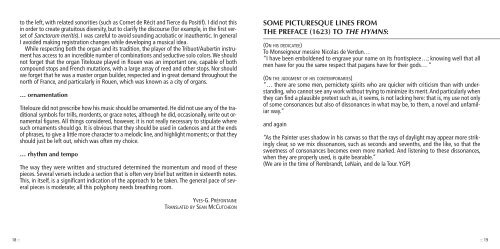You also want an ePaper? Increase the reach of your titles
YUMPU automatically turns print PDFs into web optimized ePapers that Google loves.
to the left, with related sonorities (such as Cornet de Récit and Tierce du Positif). I did not thisin order to create gratuitous diversity, but to clarify the discourse (for example, in the first versetof Sanctorum meritis). I was careful to avoid sounding acrobatic or inauthentic. In generalI avoided making registration changes while developing a musical idea.While respecting both the organ and its tradition, the player of the Tribuot/Aubertin instrumenthas access to an incredible number of combinations and seductive solo colors.We shouldnot forget that the organ Titelouze played in Rouen was an important one, capable of bothcompound stops and French mutations, with a large array of reed and other stops. Nor shouldwe forget that he was a master organ builder, respected and in great demand throughout thenorth of France, and particularly in Rouen, which was known as a city of organs.… ornamentationTitelouze did not prescribe how his music should be ornamented. He did not use any of the traditionalsymbols for trills, mordents, or grace notes, although he did, occasionally, write out ornamentalfigures. All things considered, however, it is not really necessary to stipulate wheresuch ornaments should go. It is obvious that they should be used in cadences and at the endsof phrases, to give a little more character to a melodic line, and highlight moments; or that theyshould just be left out, which was often my choice.… rhythm and tempoThe way they were written and structured determined the momentum and mood of thesepieces. Several versets include a section that is often very brief but written in sixteenth notes.This, in itself, is a significant indication of the approach to be taken. The general pace of severalpieces is moderate; all this polyphony needs breathing room.SOME PICTURESQUE LINES FROMTHE PREFACE (1623) TO THE HYMNS:(ON HIS DEDICATEE)To Monseigneur messire Nicolas de Verdun…“I have been emboldened to engrave your name on its frontispiece…; knowing well that allmen have for you the same respect that pagans have for their gods… “(ON THE JUDGMENT OF HIS CONTEMPORARIES)“… there are some men, pernickety spirits who are quicker with criticism than with understanding,who cannot see any work without trying to minimize its merit.And particularly whenthey can find a plausible pretext such as, it seems, is not lacking here: that is, my use not onlyof some consonances but also of dissonances in what may be, to them, a novel and unfamiliarway.”and again“As the Painter uses shadow in his canvas so that the rays of daylight may appear more strikinglyclear, so we mix dissonances, such as seconds and sevenths, and the like, so that thesweetness of consonances becomes even more marked. And listening to these dissonances,when they are properly used, is quite bearable.”(We are in the time of Rembrandt, LeNain, and de la Tour. YGP)YVES-G. PRÉFONTAINETRANSLATED BY SEAN MCCUTCHEON18 :::: 19
















